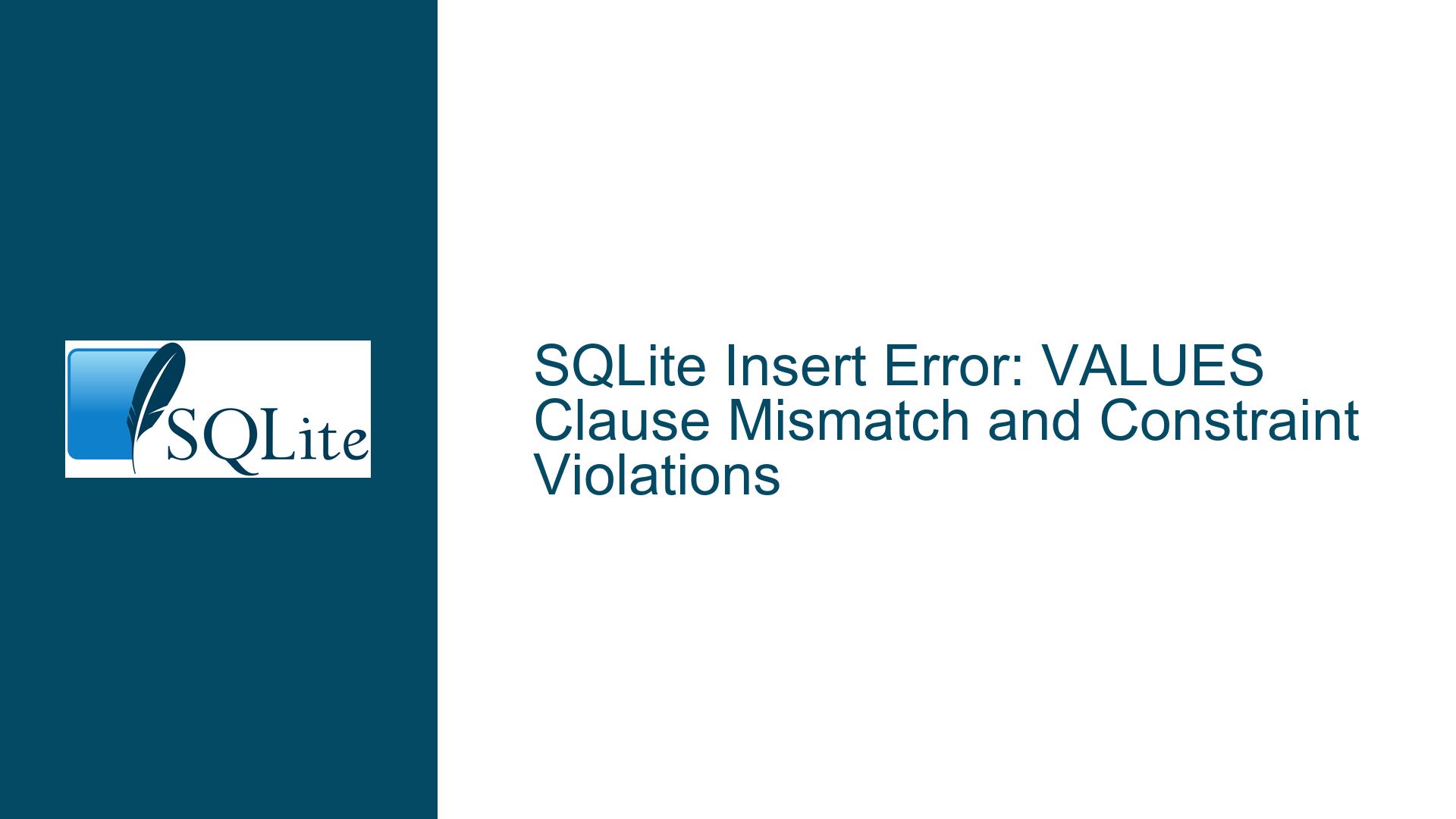SQLite Insert Error: VALUES Clause Mismatch and Constraint Violations
SQLite Insert Error: VALUES Clause Mismatch and Constraint Violations
When working with SQLite, one of the most common tasks is inserting multiple rows into a table. However, this seemingly straightforward operation can sometimes lead to errors that are difficult to diagnose, especially when dealing with large datasets. In this post, we will explore a specific issue where SQLite throws an error related to the VALUES clause and how to resolve it. We will also discuss the importance of handling NOT NULL constraints and the best practices for inserting large datasets efficiently.
Interrupted Write Operations Leading to Index Corruption
The error message "Error: near line 1: all VALUES must have the same number of terms" typically indicates that there is a mismatch in the number of values provided in the INSERT statement compared to the number of columns specified in the table schema. This error can occur for several reasons, including syntax errors, missing or extra values, or even issues with the data file itself.
One of the primary causes of this error is a syntax error in the INSERT statement. For example, using a brace { instead of a parenthesis ( can lead to this error. Another common cause is the presence of NOT NULL constraints on certain columns, which can cause the insertion to fail if any of the required values are missing.
In addition to syntax errors, the way the data is being inserted can also play a role. For instance, if you are using a shell script to insert data, there may be limitations on the number of rows that can be processed at once due to buffer size constraints. This can lead to incomplete or interrupted write operations, which can corrupt the index and cause the insertion to fail.
Implementing PRAGMA journal_mode and Database Backup
To troubleshoot and resolve these issues, it is essential to follow a systematic approach. Here are the steps you can take to identify and fix the problem:
Check the Syntax of the INSERT Statement: The first step is to ensure that the syntax of the INSERT statement is correct. This includes verifying that all parentheses, commas, and semicolons are in the correct places. For example, make sure that the last line of values ends with a semicolon (
;) instead of a comma (,).Validate the Number of Values: Ensure that the number of values provided in each row matches the number of columns specified in the table schema. This can be done by manually counting the values or using a script to validate the data file.
Handle NOT NULL Constraints: If the table has NOT NULL constraints on certain columns, make sure that all required values are provided in the INSERT statement. If any values are missing, you can either provide default values or modify the table schema to allow NULL values.
Use the .read Command: Instead of redirecting input using the
<operator, use the.readcommand in the SQLite shell to read the data file. This can provide better error messages and help you pinpoint the exact location of the error.Enable .bail Option: To ensure that the insertion is an all-or-nothing operation, enable the
.bailoption in the SQLite shell. This will stop the insertion at the first error and prevent partial data from being committed. You can also wrap the INSERT statements in a transaction usingBEGINandCOMMITto ensure atomicity.Split Large Data Files: If you are dealing with a large dataset, consider splitting the data file into smaller chunks and inserting them one at a time. This can help you identify and fix errors more easily and avoid buffer size limitations.
Use PRAGMA journal_mode: To protect against data corruption in case of a power failure or other interruptions, consider using the
PRAGMA journal_modecommand to enable WAL (Write-Ahead Logging) mode. This can help ensure that your database remains consistent even in the event of an unexpected shutdown.Backup Your Database: Before making any changes to your database, always create a backup. This can be done using the
.backupcommand in the SQLite shell. Having a backup ensures that you can restore your database to its previous state if something goes wrong.
By following these steps, you can effectively troubleshoot and resolve issues related to the VALUES clause mismatch and NOT NULL constraints in SQLite. Additionally, implementing best practices such as using the .read command, enabling the .bail option, and using PRAGMA journal_mode can help you avoid similar issues in the future and ensure the integrity of your database.
Detailed Example: Inserting Multiple Rows with NOT NULL Constraints
Let’s consider a detailed example to illustrate the steps outlined above. Suppose you have a table named Biota with the following schema:
CREATE TABLE Biota (
sampid INTEGER PRIMARY KEY,
site_id INTEGER NOT NULL,
sampdate TEXT NOT NULL,
tclass TEXT,
torder TEXT,
tfamily TEXT,
tgenus TEXT,
tspecies TEXT,
subspecies TEXT,
common_name TEXT,
ffg TEXT,
quant INTEGER
);
You want to insert 2860 rows into this table using a data file named biota.sql. The first few lines of the file look like this:
INSERT INTO Biota (sampid, site_id, sampdate, tclass, torder, tfamily, tgenus, tspecies, subspecies, common_name, ffg, quant) VALUES
(1, 11, '2000-07-18', 'Annelida', 'Oligochaeta', 'Tubificidae', null, null, null, null, 'Gatherer', 22),
(2, 12, '2000-07-19', 'Insecta', 'Diptera', 'Chironomidae', null, null, null, null, 'Shredder', 15),
...
When you try to insert the data using the following command:
sqlite3 testing.db < biota.sql
You encounter the error:
Error: near line 1: all VALUES must have the same number of terms
To troubleshoot this issue, follow these steps:
Check the Syntax: Verify that the syntax of the INSERT statement is correct. Ensure that all parentheses, commas, and semicolons are in the correct places. For example, make sure that the last line of values ends with a semicolon (
;) instead of a comma (,).Validate the Number of Values: Count the number of values in each row to ensure they match the number of columns specified in the table schema. In this case, there should be 12 values in each row.
Handle NOT NULL Constraints: Ensure that all required values for columns with NOT NULL constraints are provided. In this example,
site_idandsampdateare NOT NULL, so make sure that these values are present in every row.Use the .read Command: Instead of redirecting input, use the
.readcommand in the SQLite shell to read the data file:
sqlite3 testing.db
sqlite> .read biota.sql
This will provide more detailed error messages and help you pinpoint the exact location of the error.
- Enable .bail Option: To ensure that the insertion is an all-or-nothing operation, enable the
.bailoption:
sqlite3 testing.db
sqlite> .bail on
sqlite> .read biota.sql
This will stop the insertion at the first error and prevent partial data from being committed.
Split Large Data Files: If the data file is too large, consider splitting it into smaller chunks and inserting them one at a time. This can help you identify and fix errors more easily.
Use PRAGMA journal_mode: To protect against data corruption, enable WAL mode:
sqlite3 testing.db
sqlite> PRAGMA journal_mode=WAL;
- Backup Your Database: Before making any changes, create a backup of your database:
sqlite3 testing.db
sqlite> .backup backup.db
By following these steps, you can effectively troubleshoot and resolve the issue, ensuring that your data is inserted correctly and your database remains consistent.
Conclusion
Inserting multiple rows into an SQLite table can be a complex task, especially when dealing with large datasets and NOT NULL constraints. By following a systematic approach and implementing best practices, you can avoid common pitfalls and ensure the integrity of your database. Remember to always validate your data, use the appropriate commands and options, and create backups to protect against data loss. With these techniques, you can confidently manage your SQLite databases and handle even the most challenging data insertion tasks.






